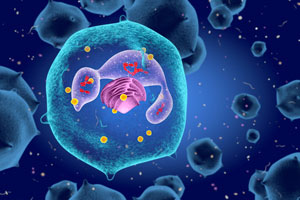
© RogerHarris/SciencePhotoLibrary/Getty
Steps in the development of first-responder immune cells have been revealed for the first time by A*STAR researchers. These insights help to illustrate how the functions of these cells might be harnessed to treat disease.
The immune cells studied were neutrophils, which regulate responses to infection, disease and injury. These cells survive in the blood for only a short time, so must be continually replenished from cells developing in the bone marrow to avoid a life-threatening condition called neutropenia. However, the process of their development is poorly understood.
“Neutrophils are considered the first line of defence of our immune system,” explains Lai Guan Ng who led the study and is from the A*STAR Singapore Immunology Network. “Better understanding their development may lead to better treatment of neutrophil-mediated inflammatory diseases or cancer.”
Neutrophils are known to originate from granulocyte–macrophage progenitor cells, but it has been unclear what steps these cells go through to produce functionally mature neutrophils. Ng and colleagues aimed to address this by analyzing the properties of developing cells in the bone marrow and identifying neutrophils through their expression of specific surface protein markers.
The researchers identified a population of proliferative cells that were committed to developing into neutrophils, which they called neutrophil precursors, or preNeus. These could develop into immature neutrophils and mature neutrophils, with each of these three cell populations having a distinct gene expression profile.
Given the importance of neutrophils to the immune response, Ng and colleagues studied how the neutrophil populations are affected in diseases. They showed that the numbers of preNeus in bone marrow increased in response to sepsis and in an animal model of pancreatic cancer. Additionally, in the cancer model, higher numbers of circulating immature neutrophils were found to be associated with larger tumors.
“We believe that our study not only provides a fundamental framework for neutrophil subset characterization, but also serves as a basis for therapeutic interventions for neutrophil-related diseases,” says Ng.
One such intervention relates to patients who receive bone marrow transplantation for blood cancers. In preparation for transplantation, neutrophils are eradicated and subsequent replacement of these cells takes some time, leaving patients vulnerable to serious infection.
“Given the proliferative and unipotent nature of the preNeus,” says Ng, “we will explore the potential of these cells to rapidly reconstitute the neutrophil pool when transferred during transplantation.”
The A*STAR-affiliated researchers contributing to this research are from the Singapore Immunology Network. For more information about the team’s research, please visit the Ng webpage.




